Too often I hear saltwater aquarists say “I feed my tang some algae a couple times a week.” as if it is a special treat or something for them to snack on. In fact, it should be the majority of their diet. There are many different ways out there to get vegetation to your predominately herbivorous fish but I prefer nori seaweed. This is basically the green paper that sushi chefs use to roll sushi up in. Some people have purchased it from a grocery store but you should be careful that you are not buying nori with added ingredients like sesame oil or spices on it for human consumption.
Honestly I like to get dried seaweeds from the aquarium companies I know and trust. One great company that has been around for a long time and is headed up by a personal hero of mine, Julian Sprung, is Two Little Fishies (www.twolittlefishies.com). They have seaweeds of different colors and types and even make them in flake form if you prefer. See their page for these different foods by clicking HERE.
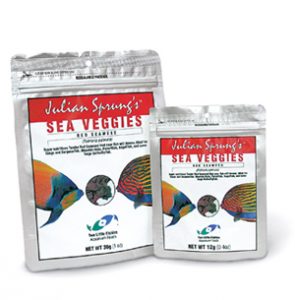
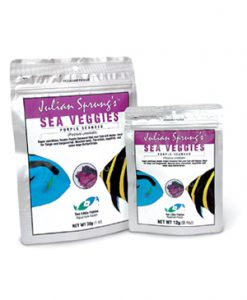
The easiest way to feed the sheets of seaweed for me is by using one of their magnetically coupled clips that pinch and hold the seaweed in place. Click HERE and scroll down until you find VeggieMag and MegaVeggieMag. They do make one that uses a suction cup that is cheap but I don’t like suction cups in saltwater. They tend to fail and fall into a spot in the aquarium which is sometimes hard to retrieve. The MegaVeggieMag is great for people who have bigger tanks with larger, more aggressive feeders. It uses a larger, more powerful magnet to better hold the algae in place.
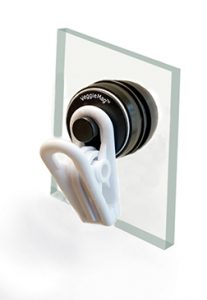
Two Little Fishies VeggieMag

Two Little Fishies MegaVeggieMag
I prefer using the algae in its original form (click HERE and scroll down until you find SeaVeggies) versus the flakes because I enjoy watching the fish graze on the food like they would in nature and also flake can often scatter all across your aquarium and contribute to polluted water if you don’t have enough scavengers to consume all the scattered food. Two Little Fishies has three different seaweeds in green, red, and purple. You will find that different fish may have a preference for a particular one. I like to mix them up because different algae will have different nutrient profiles which is great for fish health. Variety is the spice of life!
Though I provided all sorts of links to Two Little Fishies products, you can not buy directly from them. They are a manufacturer only so you will need to ask for their products at your local fish store or go online to your favorite online retailer and get it there. I like places such as Marine Depot, Bulk Reef Supply, or Premium Aquatics.
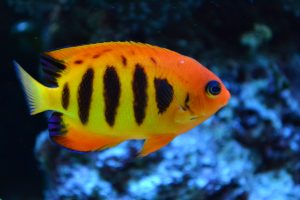
Flame angel
As a professional aquarist who goes into homes and businesses all day to examine and service aquariums, I would like to take a moment to make a VERY BIG POINT about something. PLEASE DO NOT LEAVE CONTAINERS OF SEAWEED (OR ANY FISH FOOD FOR THAT MATTER) UNDERNEATH YOUR AQUARIUM…OPEN OR OTHERWISE. This absolutely destroys the nutritional content. I find this ALL THE TIME, but not with my clients because I inform them. Oxygen, moisture and warm temperatures just suck the nutritional life out of food. I can’t even tell you how many times I’ve found open bags of seaweed underneath aquariums. Please heed my advice and keep seaweed in a sealed bag (with the air pushed out every time you open it) and in the refrigerator or freezer. Also, don’t buy so much that you have this seaweed for 5 years. An exaggeration but I wouldn’t be surprised. No reason to buy a huge amount unless you are actually going through it all in a matter of a couple months or less. If you want healthy fish, you need to be concerned with freshness of product. So buy an appropriate amount, keep it closed with the air pushed out of the bag and keep it in a fridge or freezer.
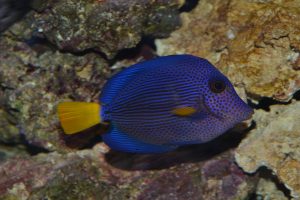
Red Sea purple tang
Another piece of advice is to only give your fish an amount that they will devour in about 5 to 10 minutes. If the algae sits there after that and isn’t being eaten, it’s just going to foul your water quality. Remove the uneaten amount from your aquarium and throw it away. Adjust the amount you put on the clip until the fish are destroying it in 5 to 10 minutes. You will need to readjust over time as the fish grow of course.
Two Little Fishies is not the only company that offers seaweed, but they do offer a greater diversity of it with the red (Palmaria palmata) and purple (Porphyra umbilicalis) varieties. Larry’s Reef Frenzy, Omega One, Ocean Nutrition, Rod’s Food, San Francisco Bay Brand, V2O…tons of companies offer it. Just pick one you think your fish like, purchase a reasonable amount, store it properly and feed it appropriately.
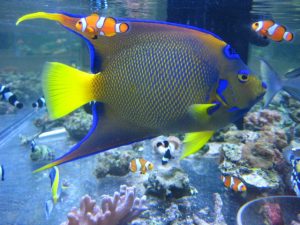
Queen angel
Let me make this clear; I’m not a fish veterinarian, marine biologist, ichthyologist or any other sort of fish specialist with a degree from an institution offering classes in those subjects. I know what I know by virtue of being around aquariums at a professional level for over 20 years. Though I am proud of that fact, I’m not going to know as much about the intricacies of fish health like the other, aforementioned individuals might be. I do know that many different marine fish such as dwarf angels, blennies, large angels (Pomacanthus, Holocanthus, Genicanthus, etc.), tangs and surgeonfish, rabbitfish….the list goes on and on….need vegetation in their diets to varying degrees. I do not know if any of them are obligate herbivores (meaning they HAVE TO only eat vegetation, like a cow) or not. I do know that many mostly herbivorous fish, like tangs and surgeonfish, will also eat animal proteins, especially when young and growing. Many other types of fish will eat the algae as well but don’t necessarily require it in as large percentage of their diet as many tangs and surgeons. The more vegetation that an animal requires in it’s diet, the more time it has to spend eating said vegetation. Vegetable matter is difficult for an animal’s digestive system to extract nutrients from. This is why an herbivore’s intestines tend to be longer than a omnivore’s or carnivore’s intestines. They need all that length in order to extract the needed nutrients. It is my opinion that many tangs (and certain other fish) need access to this sort of algae on a daily basis to be as healthy as they can be. I even read an article once by a marine biologist stating that some tangs can have a higher propensity to display aggressive and territorial behavior if made to starve (by not giving daily access to marine algae) or eat too many inappropriate foods (animal proteins). Sorry I do not have that article handy. I will look for it and edit this when I find it.
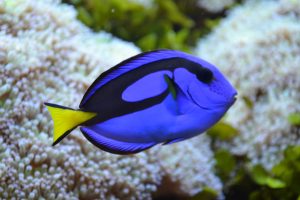
Regal tang
My advice is to study up on any prospective fish you want to keep so you will know it’s diet, potential size, demeanor towards other fish or conspecifics (which means fish of the same species), specialized nutritional needs, or any other details that you would need to know so you can adequately and properly care for the animal.
I hope this helps you take better care of your fish. Please comment and share it with your friends if you do find it helpful.Thank you for reading!
Ben Johnson – Captive Aquatic Ecosystems – 713-385-1297 – ben@caecosystems.com – custom aquarium installation and scheduled maintenance in Houston, Texas and beyond.

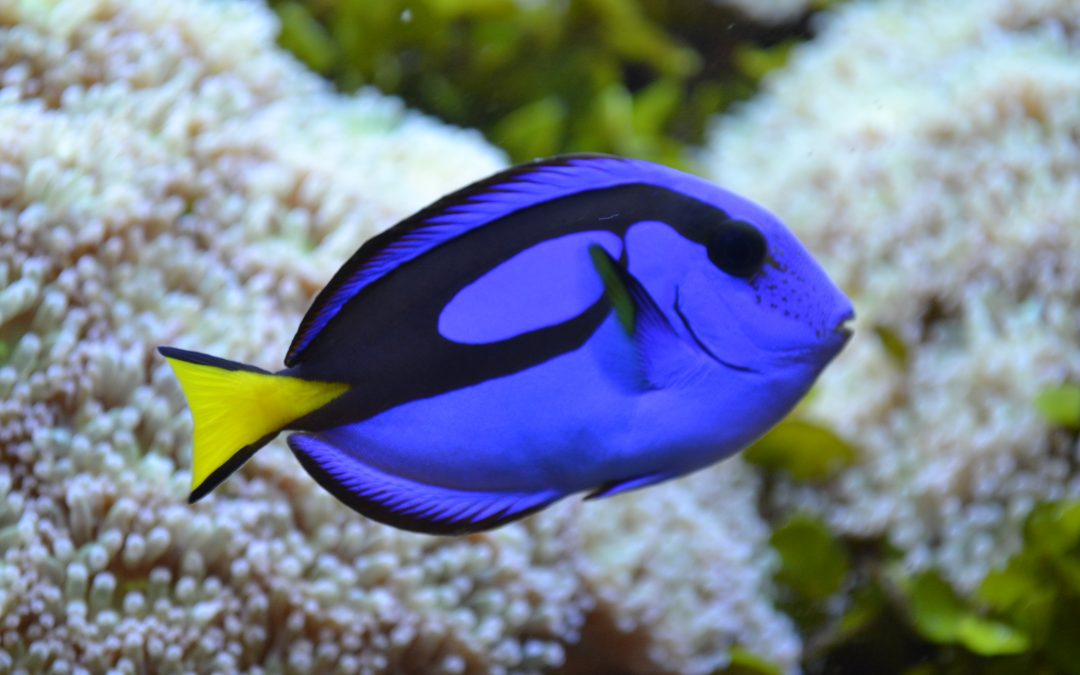
Recent Comments